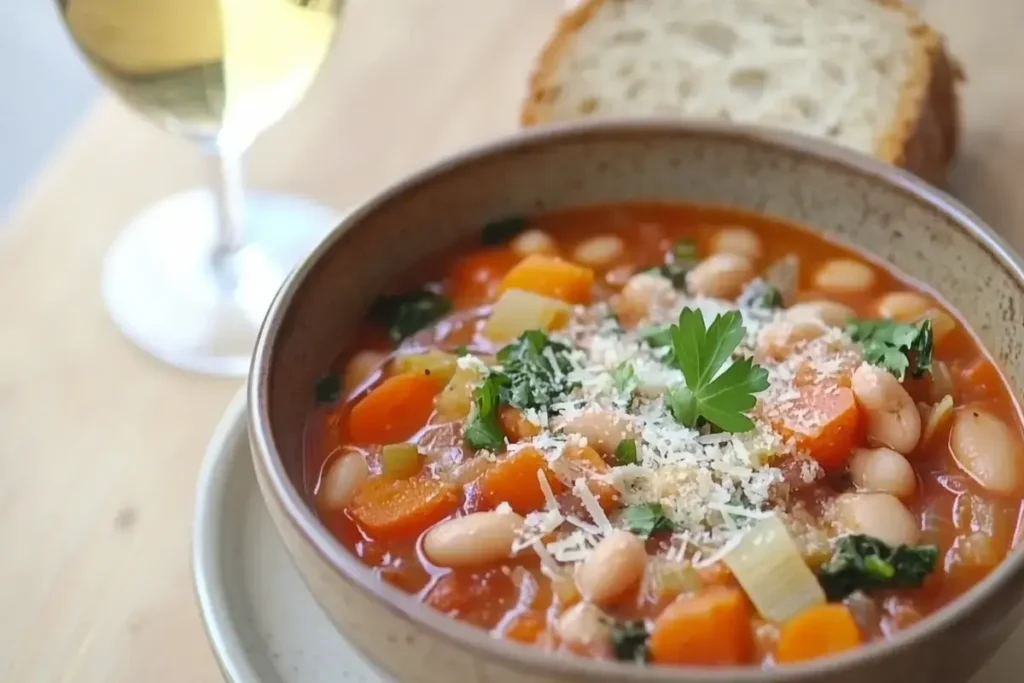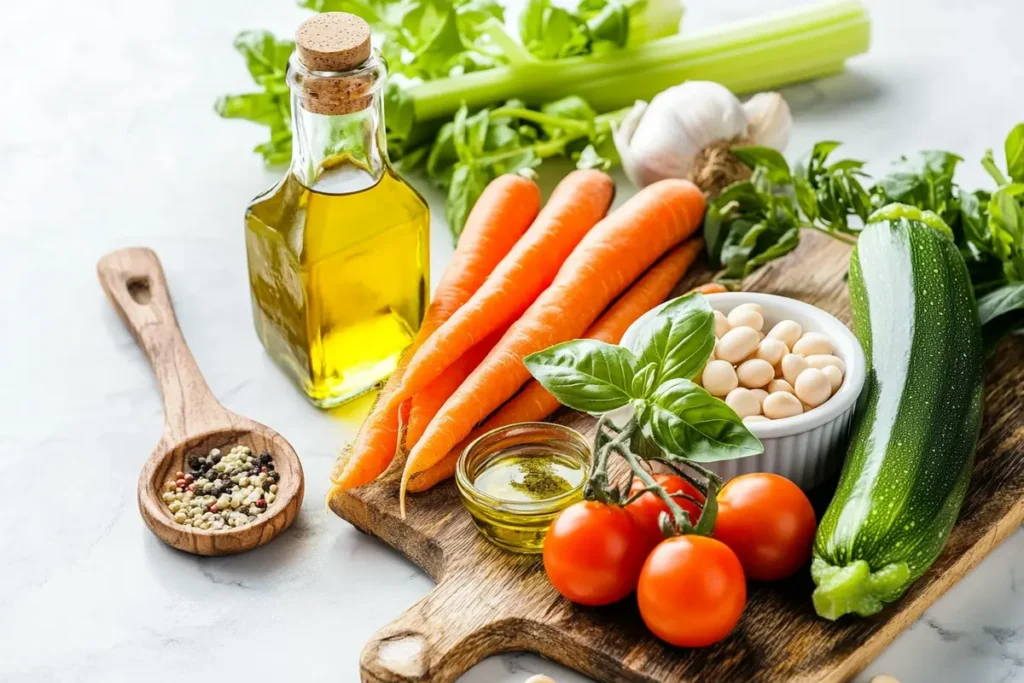Minestrone is a hearty, wholesome soup that has its roots in Italian cuisine. Known for its vibrant medley of vegetables, beans, and pasta, this dish is a delicious way to enjoy a nutritious and filling meal. Whether you’re looking for a comforting bowl of soup on a chilly day or a light yet satisfying dish, this Minestrone recipe is perfect.

In this guide, we’ll cover everything you need to know about making an authentic Minestrone, including tips, variations, and pairing suggestions.
Ingredients for Minestrone
Key Ingredients and Their Roles
- Vegetables:
- Onion, Carrot, and Celery: These form the classic soffritto base, giving Minestrone its depth of flavor.
- Zucchini, Green Beans, and Spinach: Add texture, nutrients, and color.
- Tomatoes: Fresh or canned, they provide a tangy, rich base.
- Beans:
Cannellini beans or kidney beans are essential for the creamy texture and protein content. - Pasta or Rice:
Small pasta shapes like ditalini or orzo are traditional, but rice works as a gluten-free alternative. - Broth:
A flavorful vegetable or chicken broth acts as the soup’s foundation. - Seasonings:
Garlic, Italian herbs (basil, oregano, thyme), salt, and pepper bring out the classic Italian taste. - Olive Oil:
High-quality extra virgin olive oil enhances the richness of the soup.

Substitutions and Variations
- Vegetables: Swap zucchini with yellow squash or add seasonal vegetables like kale or butternut squash.
- Beans: Try chickpeas or lentils for a different texture.
- Pasta: Substitute with quinoa or farro for added nutritional value.
- Broth: For a vegan option, ensure the broth is vegetable-based.
Step-by-Step Guide to Making Minestrone
Step 1: Preparing the Vegetables
Start by dicing the onion, carrots, and celery. Chop the zucchini, green beans, and spinach into bite-sized pieces. Mince the garlic. Prepping these ingredients in advance ensures a smooth cooking process.
Step 2: Sautéing the Aromatics
In a large soup pot, heat olive oil over medium heat. Add the onion, carrot, and celery, cooking until softened and fragrant, about 5-7 minutes. Stir in the garlic and cook for another minute.
Step 3: Adding Tomatoes and Broth
Add the chopped tomatoes (or canned, if preferred) to the pot. Stir well, allowing the flavors to meld. Pour in the vegetable or chicken broth, scraping the bottom of the pot to deglaze.
Step 4: Simmering the Soup
Bring the soup to a gentle boil, then reduce to a simmer. Add the green beans, zucchini, and beans (canned or pre-cooked). Cover the pot and let the soup simmer for about 20-25 minutes to allow the flavors to develop.
Step 5: Cooking the Pasta
Separately cook the pasta in salted boiling water until al dente. Drain and set aside. Adding pasta separately prevents it from absorbing too much liquid and becoming mushy.
Step 6: Finishing Touches
Stir in the spinach and cooked pasta, letting them heat through for 5 minutes. Adjust the seasoning with salt, pepper, and Italian herbs. Drizzle with olive oil for added richness.
Tips for the Perfect Minestrone
1. Balancing Flavors
- Acidity: Tomatoes provide a tangy base, but a splash of balsamic vinegar can enhance the depth.
- Sweetness: Carrots and onions naturally balance the acidity, but a pinch of sugar can be added if needed.
2. Texture
- For a creamier texture, mash a portion of the beans before adding them to the soup.
- Keep the vegetables slightly firm to maintain a satisfying bite.
3. Batch Cooking
Minestrone freezes well. Prepare a large batch, let it cool, and store it in freezer-safe containers for quick meals.
Nutritional Information
Calories and Macronutrient Breakdown
A typical serving of Minestrone offers:
- Calories: Around 250-300, depending on the pasta and vegetables used.
- Protein: About 10-12 grams, primarily from beans.
- Carbohydrates: 30-35 grams from vegetables, pasta, and beans.
- Fat: 7-10 grams from olive oil.
Health Benefits of Key Ingredients
- Vegetables: High in fiber, vitamins, and antioxidants.
- Beans: Excellent source of plant-based protein and iron.
- Olive Oil: Contains healthy monounsaturated fats and antioxidants.
Pairing Suggestions for Minestrone
1. Best Wines to Pair
- White Wine: A crisp Pinot Grigio complements the light and fresh flavors.
- Red Wine: A medium-bodied Chianti pairs well with the tomato-based broth.
2. Side Dishes
- Crusty Bread: Serve with rustic Italian bread or focaccia for dipping.
- Salad: A simple green salad with a lemon vinaigrette adds freshness to the meal.
3. Serving Presentation
Ladle Minestrone into deep bowls, garnish with freshly grated Parmesan cheese and chopped parsley.
Frequently Asked Questions
1. Can I Make Minestrone Gluten-Free?
Yes, replace the pasta with gluten-free options like rice or quinoa. Ensure the broth is also gluten-free.
2. Can I Use Frozen Vegetables?
Absolutely. Frozen green beans or spinach work well and save prep time.
3. How Long Can I Store Minestrone?
Minestrone can be refrigerated for up to 4 days. Freeze for up to 3 months.
4. What’s the Origin of Minestrone?
Minestrone originated in Italy as a “poor man’s soup,” made with leftover vegetables and pantry staples. It’s now a beloved dish worldwide.
5. Can I Add Meat to Minestrone?
While traditionally vegetarian, you can add cooked sausage, ground beef, or chicken for extra protein.
Conclusion
Minestrone is a timeless Italian classic that’s hearty, nutritious, and endlessly versatile. This recipe allows you to enjoy a comforting bowl of soup, whether it’s a cold winter evening or a light summer meal. With fresh vegetables, tender beans, and perfectly cooked pasta, this Minestrone recipe is a celebration of wholesome ingredients and rich flavors.
Try this recipe today and bring a taste of Italy to your table. Pair it with your favorite wine, serve it with crusty bread, and enjoy the comforting warmth of this delicious soup. Buon appetito!